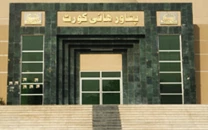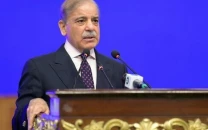Govt paints gloomy outlook of economy
Ministry says political instability, delay in IMF deal causing distress

The government, while projecting further hike in inflation coupled with a slowdown of the economy, on Friday said that delay in finalising a deal with the International Monetary Fund was causing economic distress in the country.
In its monthly outlook report, the economic adviser wing of the finance ministry also said that political instability has started feeding strong inflationary expectations.
While holding back its inflation forecast figure for the outgoing month, the finance ministry painted a gloomy outlook of the economy. It said that the Monthly Economic Indicator -- a tool to predict the economic growth rate based on the past and current indicators -- has further slowed.
The report also revealed that the total cost of the PM’s free wheat flour subsidy was nearly Rs100 billion, including Rs15.6 billion that the government of Sindh was disbursing through a preferred targeted mechanism under the Benazir Income Support Programme. Punjab will give Rs64 billion wheat flour subsidy and Khyber-Pakhtunkhwa, Rs19.7 billion in an untargeted manner.
“Inflation in March may remain in the upper bound as observed in February when it was 31.5%,” the finance ministry stated. Although the ministry did not give a figure this time, the market is expecting inflation shooting up to 36% due to a host of negative measures.
A conservative internal assessment of the finance ministry suggested around 34% inflation rate in March. The finance ministry said that a “potential reason of rising price level is political and economic uncertainty”.
The ministry also noted that delay in finalising the IMF programme was causing more pains. “The economic distress resulting from delay of the stabilisation programme has exacerbated the economic uncertainty due to which inflationary expectations have remained strong,” the report said.
Pakistan has been struggling hard to revive the $6.5 billion derailed IMF programme, although its own missteps like the petrol subsidy and attempts to directly borrow from commercial banks have further complicated the matters for the country.
The finance ministry said that even the contractionary monetary policies were not helping to contain inflation.
“Despite the SBP's contractionary monetary policy, the inflationary expectations are not settling down,” said the finance ministry in a remark that shows its dissatisfaction with the central bank’s tight monetary policy.
The SBP increased the policy rate by 3% to 20% in the last Monetary Policy decision held this month.
The monthly outlook stated that the bulk buying during Ramadan may cause demand supply gap and result in the prices of essential items to escalate. Due to the lagged effect of floods, production losses, especially of major agriculture crops, have not yet been fully recovered. Consequently, the shortage of essential items has emerged and persisted.
As a result, “inflation is expected to stay at elevated levels owing to market frictions caused by relative demand and supply gap of essential items, exchange rate depreciation and recent upward adjustment of administered prices of petrol and diesel”, it added.
The report stated that the prime minister has announced a Ramzan package under which providing free wheat flour will be provided to the inflation-hit people.
It added that the government of Punjab has allocated Rs64 billion whereby 15.8 million households falling in poverty would be provided three free flour bags of 10kg each. Earlier, Punjab's subsidy estimate was Rs53 billion.
Khyber-Pakhtunkhwa has announced Rs19.7 billion to provide three wheat flour bags of 10kg amongst its 5.8 million households. The government of Balochistan will distribute 0.5 million flour bags of 20kg. However, the government of Sindh has announced Rs15.6 billion to provide Rs2,000 to purchase wheat flour by its 7.8 million families registered with BISP, according to the finance ministry.
Another inflationary factor was the decision to increase the wheat support price by 77% to Rs39,000 per 40kg for the next crop. For Rabi season 2022-23, the harvest of wheat crop has been started in Sindh while it is going to be harvested in Punjab by the end of March.
Economic Outlook
The finance ministry stated that the average Monthly Economic Indicator (MEI) during the first eight months of the current fiscal year is indicating a further slowdown in domestic economic activities. This seems to be driven by lack of industrial dynamism, accelerating inflation, which erodes the purchasing power of consumers and investors, and is also illustrated by negative growth in exports and imports.
The indicator was already in the negative territory since the start of the fiscal year. The finance ministry’s latest assessment indicates that there may not be any growth during the current fiscal year, if no improvement is witnessed in the remainder period.
The MEI is developed as a tool to distribute the past annual GDP numbers, as reported by the PBS, on a monthly and quarterly basis and to forecast on that same frequency GDP growth for the fiscal year in which the national accounts are not yet available.
There was also depressing news on large scale manufacturing, as the report stated that “year-on-year growth of LSM is expected to remain negative in February while monthly LSM is expected to remain positive”.
LSM performance remained under pressure and witnessed a contraction of 4.4% during July-January period owing to increasingly synchronised policy stance to correct the imbalances, supply chain disruptions and recessionary global pressure. The performance of the auto industry also remains subdued due to massive increases in input prices, tightening auto finance, and import restrictions.
Fiscal performance
Fiscal deficit during the first seven month of the current fiscal year has been contained to 2.3% of the GDP against 2.8% of GDP last year. Total expenditures grew by 10%, largely driven by the expenditures on mark-up payments which grew 73% due to higher servicing on domestic and foreign debt as a result of higher interest rates, according to the report.
On the other hand, non-mark-up expenditures reduced by 26% owing to a significant decline in the subsidies and grants.
For the month of March, it is expected that the exports and the imports will remain at current levels due to slow growth in the major trading partners and contained domestic economic activities. However, remittances will probably further improve due to a positive seasonal and Ramadan factor. Taking these factors into account, the current account deficit is likely to remain on lower side.
Through demand management policies, the government is trying to limit the current account deficit, which will not transfer further pressure on dwindling reserves, it added.



















COMMENTS
Comments are moderated and generally will be posted if they are on-topic and not abusive.
For more information, please see our Comments FAQ